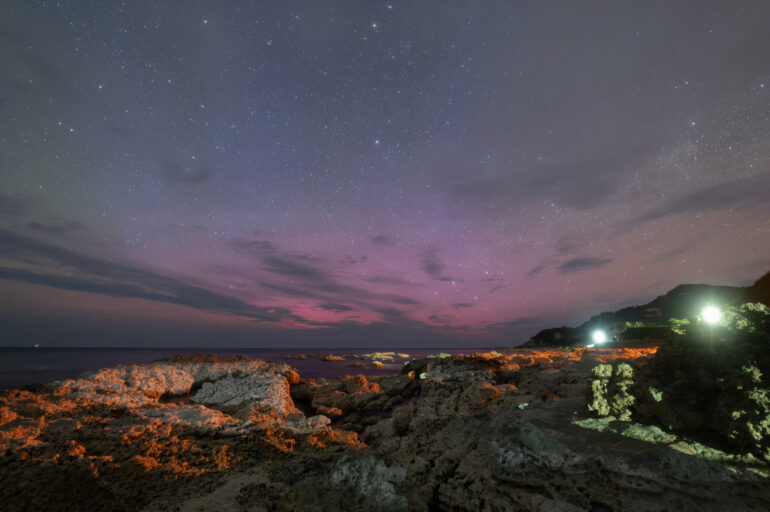Colorful auroras appeared around Japan’s Honshu and Hokkaido islands on May 11, 2024, sparked by an intense magnetic storm. Usually, auroras observed at low latitudes appear red due to the emission of oxygen atoms. But on this day, a salmon pink aurora was observed throughout the night, while an unusually tall, blue-dominant aurora appeared shortly before midnight.
Smartphone videos and amateur photos captured the event, enabling scientists to combine public data with their own research and study the phenomenon.
In a new study, researchers analyzed the videos and images of the blue-dominant aurora to estimate the area of the phenomenon and confirmed the estimates with spectrophotometers.
Published in the journal Earth, Planets and Space, the research was led by Sota Nanjo, a postdoctoral researcher at the Swedish Institute of Space Physics in Sweden, and Professor Kazuo Shiokawa from the Institute for Space-Earth Environmental Research (ISEE) at Nagoya University in Japan.
Nanjo and Shiokawa’s investigation provided the first visualization of the spatial structure of blue-dominant auroras during a storm. The researchers found that the auroras had longitudinal structures that were aligned with magnetic field lines, the first time they had been identified in a low-latitude, blue-dominant aurora.
They also found that the aurora spanned about 1,200 km in longitude, consisted of three separate structures, and ranged in altitude from 400–900 km.

Blue-dominant aurora captured by another photographer was also analyzed in this study. © Mitsuhiro Ozaki
Nanjo and Shiokawa’s findings may change our understanding of blue auroras. The ring current, a donut-shaped region of charged particles encircling Earth, is believed to be the source of energetic neutral atoms (ENAs) that produce low-latitude auroras, including the red aurora. According to this model, the storm likely energized the ENAs, creating a colorful display of light.
However, the group’s discoveries cannot easily be explained by this mechanism. As Shiokawa explains, “In this study, a structure of several hundred kilometers was found in the blue-dominant aurora in the longitudinal direction, which is difficult to interpret by ENA activity only. In addition, ENAs are unlikely to create auroral structures aligned with magnetic field lines, as observed in this study.”
Another possibility was that the aurora was due to resonant scattering of nitrogen molecular ions caused by sunlight irradiation. However, the group’s research suggests that a different process occurred, as sunlight only reached down to 700 km, not the 400 km observed by the researchers.
Instead, their results may indicate the intriguing possibility of an unidentified process. “Our findings suggest that nitrogen molecular ions may have accelerated upward by some mechanism and were responsible for the formation of the blue-dominant aurora,” Shiokawa said.
“To date, it is not well understood how nitrogen molecular ions with large molecular weight can exist at such high altitudes,” he continued. “Such ions are not easily able to exist for long periods of time due to their heavy mass and short dissociative-recombination time intervals; however, they are observed at high altitudes. The process is shrouded in mystery.”
Overall, repeated observations of blue-dominant auroras, such as the one observed in Japan, may provide clues to understand the principle behind how nitrogen can be found at these altitudes.
As the process of nitrogen molecular ion outflow into the magnetosphere is important in everything from understanding geomagnetic storms and the radiation environment in space, these findings could help us understand the processes that take place hundreds of kilometers above us.
More information:
Sota Nanjo et al, Spatial structures of blue low-latitude aurora observed from Japan during the extreme geomagnetic storm of May 2024, Earth, Planets and Space (2024). DOI: 10.1186/s40623-024-02090-9
Citation:
Citizen scientist data help uncover the mysteries of a blue low-latitude aurora (2024, December 5)



